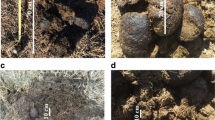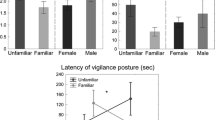Abstract
In order for an olfactory signal to be effective, it must persist in the environment for an extended period. White rhino dung odours transmit information about sex, age, territorial and oestrous states. As these odours relay important information, temporal changes in the odour emission rate and/or composition may be critical in order for other individuals to obtain this information. Here, we examine how the dung odours of adult white rhinos (male: territorial and non-territorial; female: oestrous and non-oestrous) change over the short (hours) and long (seasons) term using headspace extraction. Additionally, we measure seasonal midden visitation and defecation frequency to link behaviours to seasonal changes in odour longevity. We found that during the dry season, territorial male dung odours persisted for 48 hours, while the odours of all other adults persisted for >48 hours. The high temperature and humidity of the wet season did not affect odour longevity of oestrous females, but decreased dung odour longevity (i.e. increased emission) of territorial males, non-territorial males, and non-oestrous females. Despite this reduction, neither males nor females adjusted their seasonal visitation or defecation frequency. With regard to a temporal indicator, 3,7-dimethly-1,6-octadiene signalled dung age during the wet season, while acetophenone signalled dung age during the dry season. Ultimately, our results provide the first detailed account of temporal changes of dung VOCs, and highlight the limitations of dung as a signalling medium.






Similar content being viewed by others
Change history
08 March 2019
The original version of this article unfortunately contained some mistakes.
08 March 2019
The original version of this article unfortunately contained some mistakes.
References
Amirav A, Dagan S (1997) A direct sample introduction device for mass spectrometry studies and gas chromatorgraphy mass spectrometry anlyses. Eur J Mass Spectr 3:105–111
Archunan G, Rajagopal T (2013) Detection of estrus in Indian blackbuck: Behavioural, hormonal and urinary volatiles evaluation. Gen Comp Endocrinol 181:156–166
Beauchamp GK, Berüter J (1973) Source and stability of attractive components in guinea pig (Cavia porcellus) urine. Behav Biol 9:43–47
Brachares JS, Arcese P (1999) Scent marking in a territorial African antelope: II. The economics of marking with faeces. Anim Behav 57:11–17
Buesching CD, Waterhouse JS, Macdonald DW (2002) Gas-chromatographic analyses of the subcaudal gland secretion of the European badger (Meles meles) part II: time-related variation in the individual-specific composition. J Chem Ecol 28:57–69
Buesching CD, Tinnesand HV, Sin Y, Rosell F, Burke T, Macdonald DW (2016) Coding of Group Odor in the Subcaudal Gland Secretion of the European Badger Meles meles: Chemical Composition and Pouch Microbiota. In: Schulte BA, Goodwin TE, Ferkin MH (eds) Chemical Signals in Vertebrates 13. Springer International Publishing, Cham, pp 45–62
Darden SK, Steffensen LK, Dabelsteen T (2008) Information transfer among widely spaced individuals: latrines as a basis for communication networks in the swift fox? Anim Behav 75:425–432
Gosling LM (1982) A reassessment of the function of scent marking in territories. Z Tierpsychol 60:89–118
Gosling LM, Roberts SC (2001a) Scent-marking by male mammals: cheat-proof signals to competitors and mates. Adv Study Behav 30:169–217
Gosling LM, Roberts SC (2001b) Testing ideas about the function of scent marks in territories from spatial patterns. Anim Behav 62:F7–F10
Hillman-Smith AKK, Owen-Smith N, Anderson JL, Hall-Martin AJ, Selaladi JP (1986) Age estimation of the white rhinoceros (Ceratotherium simum). J Zool 210:355–379
Hurst JL, Robertson DHL, Tolladay U, Beynon RJ (1998) Proteins in urine scent marks of male house mice extend the longevity of olfactory signals. Anim Behav 55:1289–1297
Johnston RE, Schmidt T (1979) Responses of hamsters to scent marks of different ages. Behav Neural Biol 26:64–75
Kretzschmar P (2002) Ecological, endocrinological and ethological investigations of female mate choice in free-ranging white rhinoceros (Ceratotherium simum simum): Ernst-Moritz-Arndt-Universität Greifswald
Kwak J, Willse A, Matsumura K, Opiekun M, Yi W, Preti G, Yamazaki K, Beauchamp G (2008) Genetically-based olfactory signatures persist despite dietary variation. PLoS One 3:10
Leclaire S, Nielsen JF, Drea CM (2014) Bacterial communities in meerkat anal scent secretions vary with host sex, age, and group membership. Behav Ecol 24:996–1004
Liaw A, Wiener M (2012) Classification and regression by randomForest. R News 2:18–22
Lindemann H (1982) African rhinoceroses in captivity. University of Copenhagen, Copenhagen
Lunt N, Mhlanga MR (2011) Defecation rate variability in the common duiker: importance of food quality, season, sex and age. S Afr J Wildl Res 41:29–35
Lydell K, Doty RL (1972) Male rat odor preferences for female urine as a function of sexual experience, urine age, and urine source. Horm Behav 3:205–212
Macdonald E, Fernandez-Duque E, Evans S, Hagey L (2008) Sex, age, and family differences in the chemical composition of owl monkey (Aotus nancymaae) subcaudal scent secretions. Amer J Primatology 70:12–18
Marneweck C, Jürgens A, Shrader AM (2017) Dung odours signal sex, age, territorial and oestrous state in white rhinos. Proc R Soc B Biol Sci 284:20162376
Marneweck D, Cameron EZ, Ganswind A, Dalerum F (2015) Behavioural and endocrine correlates to the aardwolf mating system. Mammalian Biol 80:31–38
Martín J, López P (2013) Effects of global warming on sensory ecology of rock lizards: increased temperatures alter the efficacy of sexual chemical signals. Funct Ecol 27:1332–1340
Nimmermark S, Gustafsson G (2005) Influence of temperature, humidity and ventilation rate on the release of odor and ammonia in a floor housing system for laying hens. Agric Eng Int 7:1–14
Oliveira DGR, Macedo RH (2010) Functional context of scent-marking in Callithrix penicillata. Folia Primatol 81:73–85
Osbourn AE, Lanzotti V (2009) Plant-derived Natural Products: Synthesis, Function, and Application. Springer, New York
Owen-Smith N (1971) Territoriality in the white rhinoceros (Ceratotherium simum) Burchell. Nature 231:294–296
Owen-Smith N (1973) The behavioural ecology of the white rhinoceros. University of Wisconsin, Madison
Owen-Smith N (1988) Megaherbivores. The influence of very large body size on ecology. Cambridge University Press, Cambridge
Peñuelas J, Llusià J (2001) The complexity of factors driving volatile organic compound emissions by plants. Biol Plant 44:481–487
Pinheiro J, Bates D, DebRoy S, Sarkar D, Team RC (2015) nlme: linear and nonlinear mixed effects model. R package version 3:1–120
Ralls K, Smith DA (2004) Latrine use by San Joaquin kit foxes (Vulpes macrotis mutica) and coyotes (Canis latrans). W North Amer Nat 64:544–547
Regnier FE, Goodwin M (1977) On the chemical and environmental modulation of pheromone release from vertebrate scent marks. In: Müller-Schwarze D, Mozell MM (eds) Chemical Signals in Vertebrates. Springer US, New York, pp 115–133
Roberts SC (1998) Behavioural responses to scent marks of increasing age in klipspringer Oreotragus oreotragus. Ethology 104:585–592
Roper TJ, Conradt L, Butler J, Christian SE, Ostler J, Schmid TK (1993) Territorial marking with faeces in badgers (Meles meles): a comparison of boundary and hinterland latrine use. Behaviour 127:289–307
Shrader AM, Owen-Smith N, Ogutu JO (2006) How a mega-grazer copes with the dry season: food and nutrient intake rates by white rhinoceros in the wild. Funct Ecol 20:376–384
Stoddart DM (1976) Mammalian odours and pheromones. Edward Arnold Ltd., London
Stoffel MA, Caspers BA, Forcada J, Giannakara A, Baier M, Eberhart-Phillips L, Muller C, Hoffman JI (2015) Chemical fingerprints encode mother-offspring similarity, colony membership, relatedness, and genetic quality in fur seals. Proc Nat Acad Sci USA 112:E5005–E5012
van der Goot AC, Martin GB, Millar RP, Paris MC, Ganswindt A (2015) Profiling patterns of fecal 20-oxopregnane concentrations during ovarian cycles in free-ranging southern white rhinoceros (Ceratotherium simum simum). Anim Reprod Sci 161:89–95
Verheggen FJ, Haubruge E, Mescher MC (2010) Alarm pheromones: chemical signaling in response to danger. Vitam Horm 83:215–239
White AM, Swaisgood R, Czekala N (2007) Ranging patterns in white rhinoceros, Ceratotherium simum simum: implications for mating strategies. Anim Behav 74:349–356
Wilson JK, Kessler A, Woods HA (2015) Noisy Communication via Airborne Infochemicals. Bioscience 65:667–677
Zala SM, Potts WK, Penn DJ (2004) Scent-marking displays provide honest signals of health and infection. Behav Ecol 15:338–344
Acknowledgements
We thank Dr. Adam Shuttleworth for processing GC-MS samples, Chris Kelly (WildlifeACT Fund) for use of camera traps, and the University of KwaZulu-Natal Gay Langmuir Bursary for Wildlife Research.
Author information
Authors and Affiliations
Corresponding author
Electronic supplementary material
ESM 1
(DOCX 169 kb)
Rights and permissions
About this article
Cite this article
Marneweck, C., Jürgens, A. & Shrader, A.M. Temporal Variation of White Rhino Dung Odours. J Chem Ecol 43, 955–965 (2017). https://doi.org/10.1007/s10886-017-0890-4
Received:
Revised:
Accepted:
Published:
Issue Date:
DOI: https://doi.org/10.1007/s10886-017-0890-4




